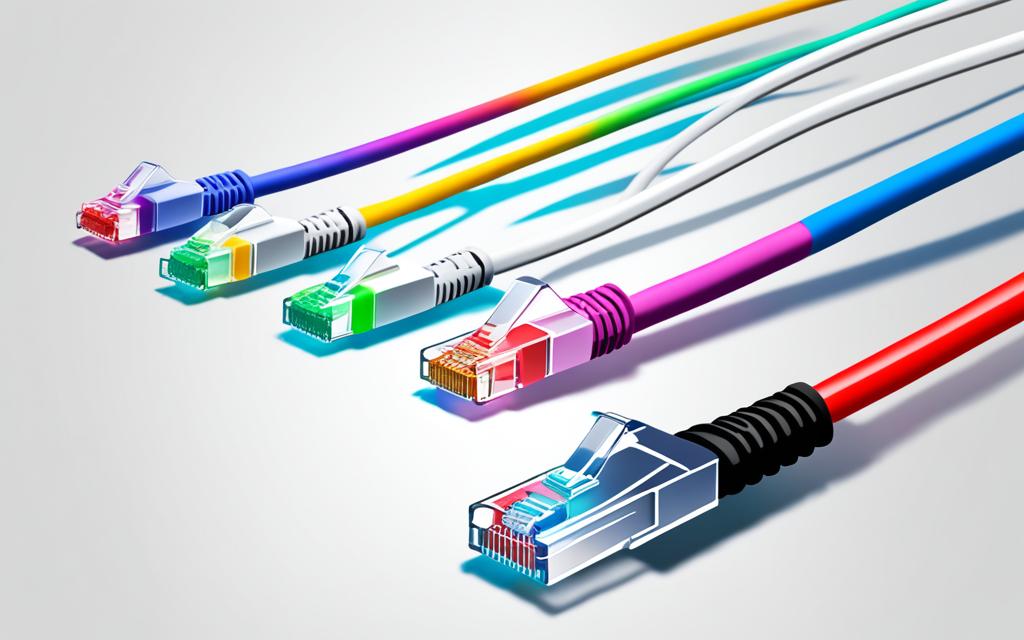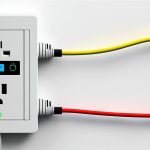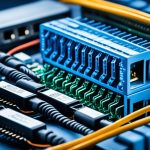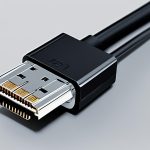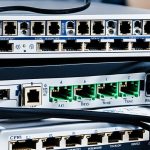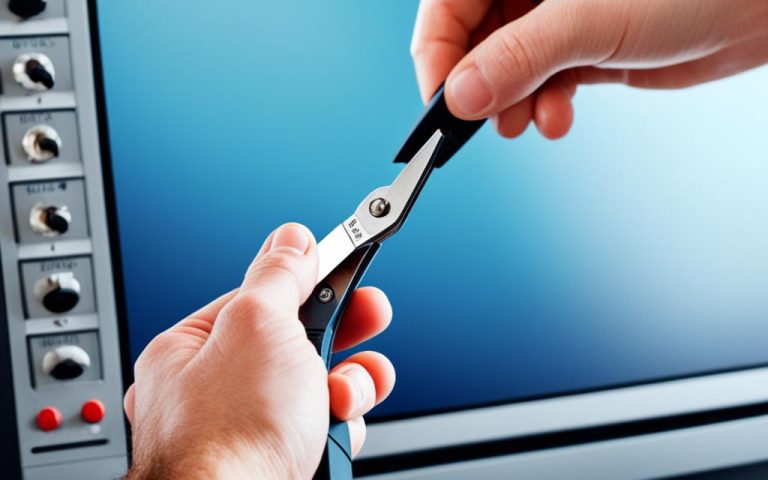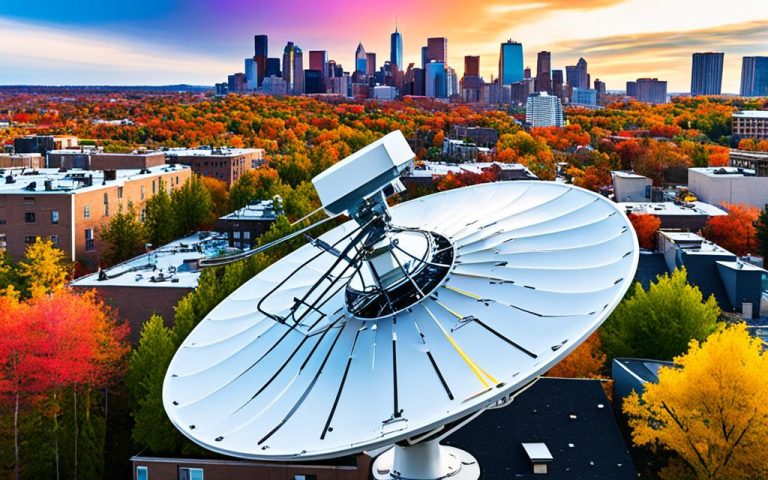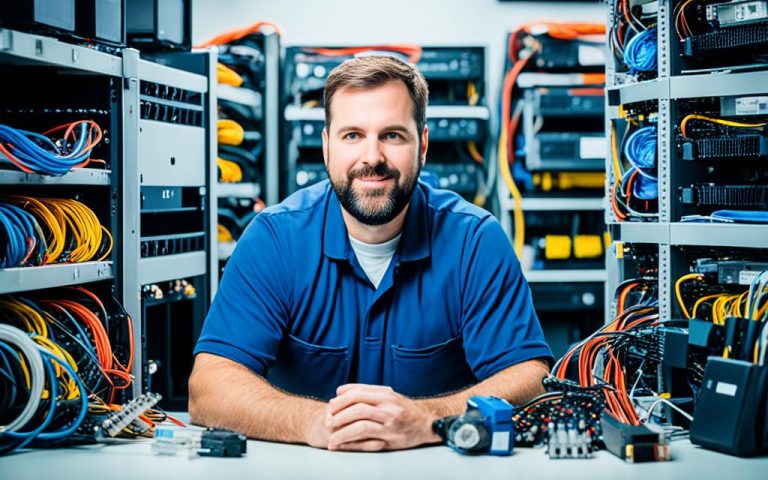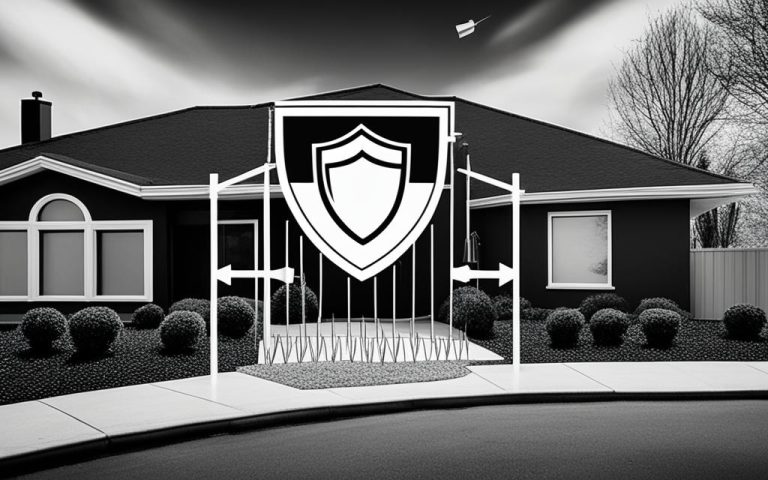Ethernet cables and network cables are often used together. They help in networking and moving data between devices or networks. Ethernet cables are a special kind of network cable that use the Ethernet protocol for sending data.
Key Takeaways:
- Ethernet cables and network cables serve the same purpose of data transmission in networking.
- Ethernet cables follow the Ethernet protocol and are a type of network cable.
When looking at Ethernet cables and other network cables, think about their speed, how fast they send data, and where they can be used. Knowing the similarities and differences helps in choosing the right cables for networks.
Ethernet cables, like Cat6 cables, can send data at speeds up to 40 Gb/s1. This is much faster than wireless networks. Ethernet cables are the best choice for reliable and quick data transfer. Wireless networks, with Wi-Fi 6, can go up to 9.6 Gb/s1, but real speeds can drop due to interference. Ethernet cables are less affected by interference, making them more reliable.
Ethernet and network cables come in copper and fiber optic types. Copper cables are reliable and affordable but slower than fiber optic cables1. Fiber optic cables send data faster and are less affected by interference, making them thinner too1.
For LAN cables, Cat6 Ethernet cables are the standard in homes and businesses1. They offer fast and stable data transfer, perfect for demanding tasks. SF/FTP cables are recommended to reduce interference1.
Ethernet cables have many benefits like faster data transfer and less interference1. But, they can be more expensive and not as mobile as wireless networks. They also have a smaller bend radius than fiber optic cables1. It’s important to think about these points when choosing cables for your network.
Ethernet cables are more secure than wireless networks because you need to physically access them to tamper with the network1. Wireless networks are more open to hacking and signal interference1.
Knowing the history of LAN technology is also key. It started in the 1970s at XEROX to connect computers and terminals, creating local area networks1.
By understanding Ethernet cables and network cables, we see Ethernet cables are a special type of network cable for efficient data transfer. Their benefits, like faster data transfer, make them a top choice for many networks. When picking cables, think about speed, materials, and security to find the best fit for your needs.
Understanding UTP Cable
Unshielded Twisted Pair (UTP) cables are key in today’s computer networks. They offer dependable and cost-effective connections for many uses.
UTP cables have four twisted pairs of copper wires without shielding. Each pair is twisted to reduce interference. This design helps UTP cables send data clearly and reliably.
Characteristics of UTP Cable
UTP cables are popular in local computer networks (LAN) for their low cost, ease, and flexibility. They support 1Gbps connections, making them perfect for office computers.
- UTP patch cables connect devices to switches, routers, or modems in Ethernet networks2.
- They have four twisted copper wires and use RJ-45 connectors2.
- UTP patch cables are short, from a few inches to a few meters, for nearby connections2.
- These cables work with Ethernet, Fast Ethernet, and Gigabit Ethernet protocols2.
Function of UTP Cable
UTP cables are crucial for networking at home and in offices. They link devices like computers, printers, and routers. They ensure fast and reliable data transfer.
UTP cables, like Cat5e UTP, support gigabit speeds for routers and computers. This means smooth streaming, quick downloads, and online gaming without lag3.
UTP patch cables connect devices to outlets without losing signal strength. They ensure efficient data transfer in a LAN3. Their low cost and simplicity make them the top choice for Ethernet cables today2.
UTP Cable vs. STP Cable
UTP cables are more flexible and simpler to install than Shielded Twisted Pair (STP) cables3. But STP cables protect against electromagnetic interference (EMI) better. This makes them good for fast networks in data centers and industrial areas3. STP cables also cost more than UTP cables3.
| UTP Cable | STP Cable |
|---|---|
| More flexible and easier to install | Enhanced protection against electromagnetic interference |
| Affordable and widely used in typical office networking | Preferred for high-speed networks in data centers and server rooms |
| Reliable 1Gbps connections for most office computers | Recommended for environments with significant electromagnetic interference |
What’s an Ethernet Cable?
Ethernet cables are key for connecting devices or networks for smooth data transfer in Local Area Networks (LANs). They were developed by Robert Metcalfe and his team at Xerox PARC in the 1970s. Now, Ethernet is the top tech for linking computers close together4.
For sending data in LANs, Ethernet cables like Category 5e (CAT5e) and Category 6 (CAT6) are often used. These cables support speeds from 10 to 10,000 Mbps. This makes them perfect for many network needs5.
Ethernet cables use twisted-pair cables with 8P8C modular RJ45 connectors for secure connections. They are known for being efficient, reliable, and secure. This makes them the top pick for tasks like streaming, gaming, and video calls6.
There are differences between Ethernet and network cables. Ethernet cables are made for LANs and work best for fast data transfer. Network cables include Ethernet, fiber optic, and more, for different uses56.
Fiber optic cables are better for long distances and high-speed needs. Ethernet cables with Power over Ethernet (PoE) can also power devices while transmitting data. This adds ease and flexibility to networks5.
It’s important to pick the right Ethernet cable for your network. Category 5e and Category 6 cables are common for LANs and ensure fast data transfer. You can choose between shielded and unshielded cables, with shielded ones protecting against interference4.
For top-notch Ethernet cables, check out Remee Wire and Cable. They offer shielded and unshielded Category 5e and Category 6 LAN cables. Call Remee Wire and Cable at 800-431-3864 to get cables that fit your project4.
Comparison of UTP, S/FTP, and Fiber Optic Cables
Choosing the right cable for your network is key. It’s important to know the differences between UTP (Unshielded Twisted Pair), S/FTP (Shielded/Foiled Twisted Pair), and fiber optic cables. Each type has its own benefits and is best for certain networking needs.
UTP Cables (Reference:78,)
UTP cables are the top choice for computer networks because they’re affordable. They have four twisted pairs of copper wires without shielding. They’re great for local networks (LAN) because they’re cheap and easy to manage. UTP cables can go up to 100m and support 1GBASE-T (Gigabit Ethernet).
They’re often used for Ethernet in homes and small offices within 100 meters.
S/FTP Cables (Reference:8)
S/FTP cables give better protection against electromagnetic interference (EMI) than UTP cables. They have global and pair shielding, fighting off EMI better. S/FTP cables can go up to 30m and handle 40GBASE-T (40 Gigabit Ethernet).
These cables are perfect for professional projects needing strong interference resistance and privacy.
Fiber Optic Cables (Reference:79,)
Fiber optic cables don’t get affected by EMI, making them great for areas with lots of electromagnetic noise. They use glass fibers to send data as light signals. This means they can send data up to 80km and support 100GBASE-ZR (100 Gigabit Ethernet).
They’re often chosen for their long reach and EMI resistance, keeping data safe over long distances.
When picking between UTP, S/FTP, and fiber optic cables, think about cost, ease of use, distance, and EMI resistance. Ethernet cables like U/FTP, F/UTP, F/FTP, and S/FTP also vary in shielding and speed for different network needs.
Twinax cables work like fiber optics but for shorter distances, making them good for data centers.
Here’s a quick look at UTP, S/FTP, and fiber optic cables:
| Type of Cable | Shielding | Transmission Distance | Transmission Rate |
|---|---|---|---|
| UTP | Unshielded | Up to 100m | 1GBASE-T (Gigabit Ethernet) |
| S/FTP | Double Shielded | Up to 30m | 40GBASE-T (40 Gigabit Ethernet) |
| Fiber Optic | Immune to EMI | Up to 80km | 100GBASE-ZR (100 Gigabit Ethernet) |
Knowing what UTP, S/FTP, and fiber optic cables offer helps you pick the best one for your network.
With this info, you can choose the right cable for your network. This ensures your data moves reliably and efficiently.
Advantages and Disadvantages of UTP and Ethernet Cables
UTP (Unshielded Twisted Pair) cables and Ethernet cables are key in networking for sending data signals well. Each has pros and cons to think about when picking one for certain tasks.
Advantages of UTP Cables
UTP cables are a top pick for many networks because they’re affordable. They’re great for small businesses or groups with tight budgets. Their low cost means they’re easy to replace when needed, making them very popular10.
They’re also easy to set up and manage. Being light and flexible, they fit into tight spots and bend easily. This makes installing networks quicker and easier, saving time and effort11.
Disadvantages of UTP Cables
UTP cables have some downsides too. They’re not great against electromagnetic interference (EMI) and noise. This means they can be affected by other cables and environmental noise, which can lower data quality12.
They also don’t work well in places with a lot of EMI or high humidity. Without shielding, they’re more likely to have signal problems in these conditions. So, in places needing strong interference protection, other cables might be better11.
Advantages of Ethernet Cables
Ethernet cables, including UTP, have many benefits. They transfer data fast. Ethernet cables support a wide range of speeds, making networks run smoothly and quickly. For example, Class EA / Category 6A is great for 10 Gigabit Ethernet, offering fast and reliable connections10.
They also come in various types, giving users choices for their needs. Whether it’s UTP, shielded, or fiber optic, Ethernet cables have options for different network setups10.
Disadvantages of Ethernet Cables
Even with their benefits, Ethernet cables have some drawbacks. Unshielded ones, like UTP, can be affected by EMI and noise. This can hurt data quality, especially in busy areas11.
Also, Ethernet cables, especially the shielded ones, cost more than UTP. The extra cost comes from the shielding that protects against interference. This higher price might stop some from using them in places where budget is a big deal11.
In summary, UTP and Ethernet cables each have their own strengths and weaknesses. UTP is cheaper and easy to install, while Ethernet offers speed and flexibility. But, both can be affected by interference, which can lower data quality. Thinking about these points helps users pick the best cable for their needs, ensuring their networks work well and reliably.
Understanding the Difference Between Fiber Optic and Ethernet Cables
Fiber optic cables use light to send data, making them great for long distances13. They can go over 100 meters and send data at speeds up to 100 Gbps, much faster than Ethernet cables13. Fiber cables are faster, have more bandwidth, and are quicker than Ethernet cables13. They also don’t get affected by electromagnetic interference13.
Ethernet cables use copper wires and work well for shorter distances13. They can be affected by electromagnetic interference but are easy to set up and work with many devices13. Ethernet is also easy to expand as your network grows13.
Choosing the right cable depends on your needs and budget13. Fiber optic is best for fast data transfer over long distances and where interference is a problem13. Ethernet is better for shorter distances and is more budget-friendly13.
| Aspect | Fiber Optic Cables | Ethernet Cables |
|---|---|---|
| Speed | Up to 100 Gbps and beyond13 | Up to 10 Gbps13 |
| Bandwidth | Higher bandwidth compared to Ethernet13 | Lower bandwidth compared to fiber optics13 |
| Latency | Lower latency compared to Ethernet13 | Higher latency compared to fiber optics13 |
| Interference | Resistant to electromagnetic interference13 | Susceptible to electromagnetic interference13 |
| Application | High-speed data transfer, long-distance communication, electromagnetic interference concerns, and safety-focused environments13 | Shorter-distance transmission, cost-effective, simple, and easy-to-use environments13 |
Choosing between fiber optic and Ethernet cables depends on your project’s needs, budget, and application13. Fiber optics are great for fast, long-distance data transfer and are secure13. Ethernet is better for shorter distances and is more affordable13.
Electromagnetic Interference and Signal Security
Electromagnetic interference is a big worry with network cables, like fiber optic and Ethernet cables. It can mess with signal transmission and hurt network performance.
For Ethernet cables, unshielded twisted pair (UTP) cables are often at risk from interference. Things like microwaves and Bluetooth devices can mess with them. This can make the signal quality go down and cause network problems.
14 On the other hand, shielded Ethernet cables are made to fight electromagnetic interference. They have an extra layer of shielding around the wires. This keeps them safe from outside interference. Shielded cables are used a lot in places with lots of electronic devices, like data centers and factories.
Fiber optic cables can also face interference, but it’s different. They use light to send data, and sometimes these light signals can get mixed up. But, companies are always working to make fiber optic cables better at avoiding this issue. This means they can send data reliably.
When it comes to keeping data safe, fiber optic cables are better than Ethernet cables. They’re hard to tap, so it’s harder for others to listen in. This makes them great for places that need top-notch security, like government offices and banks.
To sum up, both fiber optic and Ethernet cables can face electromagnetic interference. Shielded Ethernet cables can help, and fiber optic cables are getting better at avoiding interference. For keeping data safe, fiber optic cables are the better choice. But, the best cable depends on what you need, like security level, the job it has to do, and the place it’s used in.
Factors to Consider in Choosing Between Fiber Optic and Ethernet Cables
Choosing between fiber optic and Ethernet cables depends on several factors. You need to think about the distance, speed, interference, and installation costs. These factors help decide the right cable for your network.
Fiber optic cables are great for sending data over long distances. They are perfect for applications that need signal transmission over a long range15. These cables connect the world, running deep under oceans and linking continents and countries15. Single-mode fiber optic cables are best for long distances because they have lower loss compared to multi-mode fibers15.
Ethernet cables are more affordable and easy to install. They work well for connections close to homes and within shorter distances15. Copper Ethernet cables, like Cat6 and Cat6a, support speeds of Gigabit and 10 Gigabit15. These cables are cost-effective, fast, and great for home networks, small offices, and short to medium-distance connections15.
Fiber optic cables are faster than Ethernet cables. Single fiber optics can send data at 100 Gigabits16. Ethernet technology has grown, with faster versions like Cat6 cables becoming standard for Ethernet networks. These cables have speeds up to twice that of Category 5e cables17.
Fiber optic cables don’t get affected by electromagnetic interference. This makes them a reliable choice for keeping signal quality high17. However, Ethernet cables, despite being slower, are cost-effective and can handle interference well, making them good for many uses16.
Installation costs and requirements are important too. Fiber optic cables are pricey to install and replace because they are fragile compared to Ethernet16. Ethernet cables, especially UTP cables, are cheaper to install and more practical for connections that don’t need long-distance transmission and where budget matters17.
Comparison Table: Fiber Optic Cables vs. Ethernet Cables
| Factors | Fiber Optic Cables | Ethernet Cables |
|---|---|---|
| Transmission Distance | Ideal for long distances | Suitable for shorter distances ( |
| Data Transmission Speed | Transmit at rates of 100 Gigabits | Available in high-speed variants like Cat6 cables (twice the performance speeds of Cat5e cables) |
| Immunity to Interference | Immune to electromagnetic interference | Can withstand interference and offer excellent signal integrity |
| Installation and Replacement Costs | Expensive compared to Ethernet | More cost-effective and easier to install |
The choice between fiber optic and Ethernet cables depends on your network needs. Fiber optic cables are best for long distances and high-speed data transfer. They’re great for connecting ISPs to street cabinets. Ethernet cables are a more affordable and practical choice for shorter distances15. Think about these factors to make a decision that fits your network.
Future Trends in Networking Cables
Technology is moving fast, and we need faster data transfer. This is driving new trends in networking cables.
Bandwidth Expansion to Support Emerging Technologies
With 5G, IoT, and AI on the rise, we need more bandwidth. By 2017, 88% of U.S. homes had internet speeds of 1 Gbps18. This shows we’re focusing on faster data transfer. To meet this need, cable makers are creating Ethernet cables for higher speeds, like Category 8 cables.
These cables can handle speeds up to 25 Gbps or even 40 Gbps18.
Advancements in Fiber Optic Cables
Fiber optic cables are great for sending data over long distances fast. Future improvements will make them cheaper without losing performance. Plastic optical fibers are being developed for higher bandwidth and better power handling18.
This will make data transfer more efficient and support new technologies.
Evolution of Power over Ethernet (PoE)
Power over Ethernet (PoE) has changed how we power and connect devices. Future PoE standards will support more power, making it easier to use devices in many areas without extra power sources19.
Advancements in Hybrid Cables
Hybrid cables combine power, data, and hydraulic lines in one. They save space and make installations easier in places where space is tight19.
Enhanced Modularity and Connectivity
New connectors are being made for networking cables. They make it easy to quickly change or remove connections, which helps with installations and upkeep. Companies want ready-made cable assemblies for their machines, making things more flexible19.
Coexistence of Cable and Wireless Technologies
Wireless tech is big, but cables are still key for reliable data transfer in industries. Data shows we’ll see both cable and wireless tech together in the future19. Cables will keep giving us secure, dependable connections for important data transfer.
Energy Efficiency Optimization
Saving energy is a big goal, and networking cables can help. DC voltage networks might replace AC ones for less energy use. But, making connectors and insulation for DC voltage is a challenge19.
Constant Upgrades and Maintenance
Keeping cables in good shape is crucial for performance. Old Ethernet cables like Cat3 and Cat5 are showing their age20. Using copper clad aluminum (CCA) can cause problems. So, it’s important to replace Ethernet cables when needed20.
The future of networking cables looks bright. With new tech in Ethernet and fiber optics, and better PoE, hybrid cables, and modularity, we’re set for a big change. Keeping up with trends and upgrading our cables will help us use new tech fully and keep our connections strong.
Conclusion
Ethernet cables and network cables are similar in many ways. They are used for data transfer between devices or networks. Ethernet cables come in different types like Cat5e, Cat6, Cat6a, and Cat7a21. These cables use copper or aluminum, unlike fiber optic cables21. The most common type is the unshielded twisted pair (UTP) cable21.
Newer Ethernet cable standards like Cat 6a, Cat 7, and Cat 8 have been made for faster internet speeds22. This meets the need for quicker connections and newer networking tech.
Even though WiFi is popular, Ethernet cables are still key. They give faster and more secure connections than WiFi21. This makes them perfect for devices like gaming consoles, desktop computers, and smart TVs that need stable, fast connections23.
Choosing between Ethernet and fiber optic cables depends on distance, speed, and how much interference you can handle. Fiber optic cables are best for long distances. Ethernet cables are great for computer networks23. Knowing the pros and cons of each cable helps you pick the right one for your needs.
FAQ
What is the difference between an Ethernet cable and a network cable?
Ethernet cables and network cables are often used together. Ethernet cables are a special type of network cable. They are made for sending data using the Ethernet protocol.
What is a UTP cable?
UTP cables, also known as unshielded twisted pair cables, are very common in computer networks. They have four pairs of copper wires twisted together. They are also quite affordable.
What is the function of an Ethernet cable?
Ethernet cables connect devices or networks for sending data. The Ethernet protocol tells us how to send data in the right format.
What are the different types of Ethernet cables?
Ethernet cables come in different materials and types. You can find U/FTP, F/UTP, F/FTP, and S/FTP cables.
How do UTP, S/FTP, and fiber optic cables compare?
UTP cables, like Ethernet cables, don’t shield against electromagnetic interference (EMI). S/FTP cables have shielding for each pair and overall shielding. Fiber optic cables send data as light signals. They have more bandwidth and don’t get affected by EMI.
What are the advantages and disadvantages of UTP and Ethernet cables?
UTP cables are affordable and easy to manage, perfect for LANs. But, they’re not good in places with EMI or high humidity. Ethernet cables send data faster but can be affected by interference. They’re not made for long distances.
What is the difference between fiber optic and Ethernet cables?
Fiber optic cables use light to send data and are great for long distances. Ethernet cables use copper wires for shorter distances. Fiber optic cables have more bandwidth and resist EMI. Ethernet cables are cheaper and easier to set up.
How does electromagnetic interference affect fiber optic and Ethernet cables?
UTP cables can cause interference with devices like microwaves and Bluetooth if not shielded. Shielded Ethernet cables can lessen this. Fiber optic cables can have interference between light signals but are getting better. Fiber optic cables are more secure than Ethernet cables.
What factors should I consider when choosing between fiber optic and Ethernet cables?
Think about the distance, how fast you need to send data, how much interference you can handle, and how easy it is to install.
What are the future trends in networking cables?
Networking cables will get better at handling more data for things like 5G, IoT, and AI. Ethernet cables will get faster with new standards like Category 8. Fiber optic cables will be more affordable. Power over Ethernet will support more power, and Hybrid Fiber-Coaxial (HFC) cables will improve for better signal quality.
What are the similarities between Ethernet cables and network cables?
Ethernet cables are a type of network cable used for sending data between devices or networks.
Source Links
- https://patchbox.com/blog/what-is-a-lan-cable/ – What is a LAN cable? Easily explained
- https://www.genuinemodules.com/is-utp-patch-cable-same-as-ethernet-cable_a637 – Is utp patch cable same as ethernet cable?
- https://www.cbtnuggets.com/blog/technology/networking/utp-vs-stp – UTP vs. STP: Understanding the Differences in Ethernet Cable Types
- https://remee.com/lan-and-ethernet-cables-whats-the-difference/ – LAN & Ethernet Cables: Learn the Difference – Remee Wire and Cable
- https://jemelectronics.com/whats-the-difference-between-ethernet-vs-network-cables/ – What’s the Difference Between Ethernet vs Network Cables?
- https://www.sfcable.com/blog/ethernet-cable-network-cable-same – Are Ethernet Cable, LAN Cable and Network Cable Same?
- https://www.baeldung.com/cs/ethernet-vs-utp-cable – What’s the Difference Between an Ethernet Cable and a UTP Cable? | Baeldung on Computer Science
- https://www.optcore.net/utp-stp-ftp-cable-difference/ – UTP vs. STP vs. FTP vs. S/FTP Cable, What is The Difference
- https://www.cablematters.com/Blog/Networking/fiber-optic-cables-vs-ethernet-cables – Fiber Optic Cables vs. Ethernet Cables: What’s the Difference? | Cable Matters Blog
- https://patchbox.com/blog/utp-vs-stp-cable-advantages-and-disadvantages/ – UTP vs. STP: What is the difference?
- https://www.cablematters.com/Blog/Networking/utp-vs-stp-cables – UTP vs. STP Cables: An In-Depth Comparison | Cable Matters Blog
- https://www.truecable.com/blogs/cable-academy/shielded-vs-unshielded-cable – Shielded vs. Unshielded Cable
- https://www.truecable.com/blogs/cable-academy/fiber-optics-vs-ethernet-understanding-the-key-differences – Fiber Optics vs Ethernet: Understanding the Key Differences
- https://cablenet.co.uk/news/detail/id/59 – Cablenet, Your no.1 source for Security and Audio Visual Products
- https://www.holightoptic.com/fiber-optic-cables-and-ethernet-cables-know-the-differences/ – Posts – HOLIGHT Fiber Optic’s Latest Updates and Insights
- https://www.bridgecable.com/fiber-optic-cable-vs-ethernet-cable/ – Fiber Optic Cable vs. Ethernet Cable | Key Differences
- https://www.cables.com/cablesblog/should-you-buy-ethernet-cables-or-fiber-optic-cables.html – Should You Buy Ethernet Cables or Fiber Optic Cables?
- https://www.cables-unlimited.com/future-trends-smaller-faster-cables-and-connectivity/ – Future Trends: Smaller, Faster Cables and Connectivity – Cables Unlimited Inc.
- https://e.lapp.com/in/five-future-trends-in-cable-technology – Five Future Trends In Cable Technology
- https://www.truecable.com/blogs/cable-academy/when-should-i-replace-ethernet-cable – When Should I Replace Ethernet Cable?
- https://medium.com/@sylvieliu66/ethernet-cable-vs-network-cable-whats-the-difference-cd7e61ba17f6 – Ethernet Cable vs Network Cable: What’s the Difference?
- https://www.genuinemodules.com/is-lan-cable-and-ethernet-cable-same_a2536 – Is lan cable and ethernet cable same?
- https://www.ghtcable.com/article/is-a-lan-cable-the-same-as-an-ethernet-cable.html – Is a LAN Cable the Same as an Ethernet Cable?

